Filtering by
- All Subjects: Evolution
- Creators: Kusumi, Kenro
- Creators: School of Human Evolution & Social Change


Bermuda Land Snails make up a genus called Poecilozonites that is endemic to Bermuda and is extensively present in its fossil record. These snails were also integral to the creation of the theory of punctuated equilibrium. The DNA of mollusks is difficult to sequence because of a class of proteins called mucopolysaccharides that are present in high concentrations in mollusk tissue, and are not removed with standard DNA extraction methods. They inhibit Polymerase Chain Reactions (PCRs) and interfere with Next Generation Sequencing methods. This paper will discuss the DNA extraction methods that were designed to remove the inhibitory proteins that were tested on another gastropod species (Pomacea canaliculata). These were chosen because they are invasive and while they are not pulmonates, they are similar enough to Bermuda Land Snails to reliably test extraction methods. The methods that were tested included two commercially available kits: the Qiagen Blood and Tissue Kit and the Omega Biotek Mollusc Extraction Kit, and one Hexadecyltrimethylammonium Bromide (CTAB) Extraction method that was modified for use on mollusk tissue. The Blood and Tissue kit produced some DNA, the mollusk kit produced almost none, and the CTAB Extraction Method produced the highest concentrations on average, and may prove to be the most viable option for future extractions. PCRs attempted with the extracted DNA have all failed, though it is likely due to an issue with reagents. Further spectrographic analysis of the DNA from the test extractions has shown that they were successful at removing mucopolysaccharides. When the protocol is optimized, it will be used to extract DNA from the tissue from six individuals from each of the two extant species of Bermuda Land Snails. This DNA will be used in several experiments involving Next Generation Sequencing, with the goal of assembling a variety of genome data. These data will then be used to a construct reference genome for Bermuda Land Snails. The genomes generated by this project will be used in population genetic analyses between individuals of the same species, and between individuals of different species. These analyses will then be used to aid in conservation efforts for the species.
Agassiz’s desert tortoise (Gopherus agassizii) is a long-lived species native to the Mojave Desert and is listed as threatened under the US Endangered Species Act. To aid conservation efforts for preserving the genetic diversity of this species, we generated a whole genome reference sequence with an annotation based on deep transcriptome sequences of adult skeletal muscle, lung, brain, and blood. The draft genome assembly for G. agassizii has a scaffold N50 length of 252 kbp and a total length of 2.4 Gbp. Genome annotation reveals 20,172 protein-coding genes in the G. agassizii assembly, and that gene structure is more similar to chicken than other turtles. We provide a series of comparative analyses demonstrating (1) that turtles are among the slowest-evolving genome-enabled reptiles, (2) amino acid changes in genes controlling desert tortoise traits such as shell development, longevity and osmoregulation, and (3) fixed variants across the Gopherus species complex in genes related to desert adaptations, including circadian rhythm and innate immune response. This G. agassizii genome reference and annotation is the first such resource for any tortoise, and will serve as a foundation for future analysis of the genetic basis of adaptations to the desert environment, allow for investigation into genomic factors affecting tortoise health, disease and longevity, and serve as a valuable resource for additional studies in this species complex.
Data Availability: All genomic and transcriptomic sequence files are available from the NIH-NCBI BioProject database (accession numbers PRJNA352725, PRJNA352726, and PRJNA281763). All genome assembly, transcriptome assembly, predicted protein, transcript, genome annotation, repeatmasker, phylogenetic trees, .vcf and GO enrichment files are available on Harvard Dataverse (doi:10.7910/DVN/EH2S9K).
Our cells need constant fuel and oxygen for the body to work properly and maintain cellular function. In high altitudes tissue oxygen levels fall and the body must work against this hypoxic challenge to maintain energetics and limit oxidative stress. Mammals living at high altitudes are challenged to sustain thermogenesis and aerobic exercise despite reduced amounts of available oxygen. Enhancements in oxidative capacity and oxygen diffusion capacity of skeletal muscle may be necessary to compensate for insufficient oxygen supply in tissues. Hypoxic conditions can cause a switch from aerobic metabolism to anaerobic metabolism. Due to previous research of Graham Scott and colleagues on “Adaptive Modifications of Muscle Phenotype in High-Altitude Deer Mice” and the SMack Lab at Arizona State University, the question of how low atmospheric oxygen levels affects the enzymatic activity in the gastrocnemius muscle of Gelada Monkeys compared to Rhesus Macaque Monkeys was researched. Lactate Dehydrogenase (LDH) activity was measured in the gastrocnemius tissue of 6 Gelada Monkeys (highland) and 6 Rhesus Macaque monkeys (lowland). LDH was expected to be greater in Gelada tissue samples due to heightened anaerobic metabolism in the presence of limited available oxygen in high altitude environments. Results showed higher LDH in Rhesus Macaque samples compared to Gelada samples, but this difference was not statistically significant. Despite nonsignificant data, this experiment is insightful into the effects of Hypoxic adaptation in skeletal muscle enzymatic activity in primates.



Cells have mechanisms in place to maintain the specific lipid composition of distinct organelles including vesicular transport by the endomembrane system and non-vesicular lipid transport by lipid transport proteins. Oxysterol Binding Proteins (OSBPs) are a family of lipid transport proteins that transfer lipids at various membrane contact sites (MCSs). OSBPs have been extensively investigated in human and yeast cells where twelve have been identified in Homo sapiens and seven in Saccharomyces cerevisiae. The evolutionary relationship between these well-characterized OSBPs is still unclear. Reconstructed OSBP phylogenies revealed that the ancestral Saccharomycotinan had four OSBPs, the ancestral Holomycotan had five OSBPs, the ancestral Holozoan had six OSBPs, the ancestral Opisthokont had three OSBPs, and the ancestral Eukaroyte had three OSBPs. Our analysis identified three clades of ancient OSBPs not present in animals or fungi.